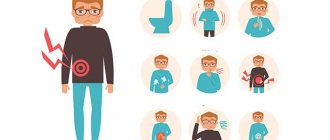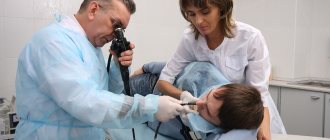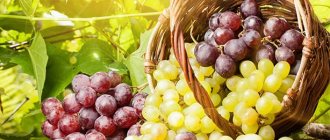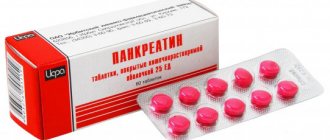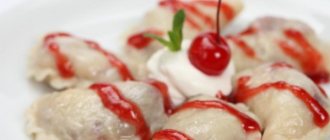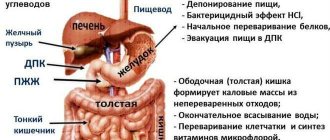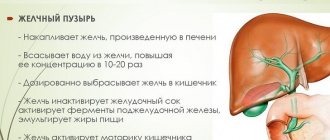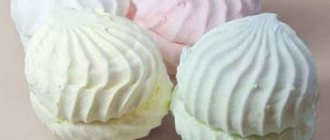Basic principles of nutrition after gastroscopy of the stomach
It is rare that the study is performed on completely healthy patients. Therefore, the nature of the diet after fibrogastroduodenoscopy is determined by the nature of the patient’s disease .
Nutrition in the period after FGDS in most cases resembles Pevzner’s diet No. 1. The nature of the violation of secretory function (hyper- or hypoproduction of hydrochloric acid) is of greatest importance. But even regardless of this, nutrition after FGDS is based on several key principles:
- Reducing the amount of food at one time , and their frequency (up to 5-6 times a day). This reduces the load on the gastric mucosa.
- Chemical protection . It is necessary to exclude from the diet foods that can damage the mucous membrane (for example, citrus fruits or alcoholic drinks).
- Thermal protection . All dishes served to the patient should be at a comfortable temperature (35-45°C). This prevents damage to the stomach wall from getting worse.
- Balance . Despite the exclusion of certain foods, the diet must maintain the required amount of nutrients (carbohydrates, proteins, fats), vitamins and microelements.
- Patient-oriented diet . The diet should take into account the patient’s preferences, since only then will he adhere to it.
Help The latest recommendations advise staying away from a strict diet.
It has not been proven that its use promotes faster recovery of the mucous membrane. Other factors play a much more important role - the presence of Helicobacter pylori infection, long-term use of certain groups of medications and concomitant diseases. These must be taken into account when preparing a diet after fibrogastroduodenoscopy.
Diet issues after fibrogastroduodenoscopy
The main symptoms that patients who underwent examinations complain about are discomfort in the throat and esophagus. In this regard, even after forced preliminary fasting, most people do not experience a strong desire for food. In any case, eating or drinking any liquid (including water) is not recommended for an hour after a gastroenterological examination.
This is explained by the inhibition of the swallowing reflex, which appears as a result of treating the throat with a local anesthetic before inserting the endoscopic tube. A person may simply choke on food or drink. In addition, under the influence of the anesthetic, the tongue and sense of taste are lost for some time. There are no strict dietary restrictions.
To alleviate your general somatic condition, you should follow some rules that will help you figure out what and when you can eat after gastroscopy:
- The first meal should not be plentiful (200-250 grams will be quite enough).
- Preference should be given to lighter dishes. These can be fermented milk products (soft cottage cheese, yogurt, fermented baked milk), creamy soups, oatmeal or semolina porridge.
- Solid food is not recommended. Hard pieces can damage the irritated mucous membrane of the throat and esophagus.
- You should not fast after FGDS for more than two hours. The stomach must be returned to normal operation.
- As for tobacco products, it is also necessary to wait an hour and not smoke immediately after the examination.
If during the examination biological material was taken for laboratory analysis (biopsy), the recommended time range of fasting after fibrogastroduodenoscopy is two hours. At the same time, it is prohibited to consume hot foods and drinks. Well-heated food can be eaten when the injured mucous membrane has recovered. Usually this happens within 24 hours.
When should you not eat or drink?
It all depends on the procedure used. Typically, FGDS is done under local anesthesia of the posterior wall of the oropharynx. Then (if there are no complications and surgery is not planned) you can eat 30 minutes after completion of the procedure.
If a biopsy of the mucous membrane was performed, then you need to refrain from eating for 2 hours after the procedure. All dishes should be warm, but not hot, as otherwise this will cause injury to the stomach wall.
, FGDS
has increasingly been performed (medicated sleep).
Considering the duration of action of the drug used for the procedure, the first meal is recommended after 90-120 minutes. Sometimes FGDS is done under general anesthesia. Then, after completing the procedure, the patient gradually withdraws from the administered medications and may complain of nausea, dizziness, and severe drowsiness for several hours. Therefore, the first feeding occurs after approximately 4-8 hours. At the same time, it should be as simple as possible (for example, buckwheat porridge) so as not to provoke vomiting.
FGDS is often performed on children under anesthesia or sedation. You can read about the features of this procedure by following the link.
FEATURES OF GASTROSCOPY
FGDS is prescribed in case of clarification of the diagnosis, if the tests performed do not answer the question about the causes of the disease. Only when diagnosed with an endoscope is it possible to perform a biopsy - removal of a small piece of gastric mucous tissue for examination.
The diagnostic procedure takes a few minutes - no more than ten. However, the preparation time and subsequent recovery after diagnosis will take about two hours. Therefore, it is necessary to have enough free time to undergo the procedure in calm conditions.
Diagnosis with an endoscope is not considered a painful procedure, but it can cause some discomfort and inconvenience. Troubles can be avoided if you relax well and trust the doctor.
Prohibited Products
Carbonated drinks (including alcoholic drinks, kvass, lemonade and mineral water) from the diet that is recommended after FGDS It is also prohibited to drink strong tea or coffee as drinks, as they can stimulate the production of hydrochloric acid by the gastric mucosa.
Also, meat (chicken) broths can increase acidity, so they are also not included in the diet in the presence of hypersecretory conditions. Fatty meats (pork, duck, goose) have a similar effect. The diet also does not include soups with a large amount of spices, red borscht and okroshka.
Gels and suspensions will help cope with stomach pain. Which? This article will tell you about this.
Please note: Fresh baked goods negatively affect the digestive processes, as do pastry products. If a patient buys pies, then you need to pay attention to the nature of the filling.
With high acidity, fermented milk products (kefir, fermented baked milk) are not recommended. They can potentiate the effect of the aggression factor (hydrochloric acid) on the mucous membrane. Some types of hard cheese contain a large amount of spices and therefore should not be eaten.
If you look at vegetables, onions, radishes, rutabaga, cucumbers, spinach, and white cabbage are not included in the diet.
You should avoid eating peanuts, legumes, and nuts. All sour berries (blueberries, strawberries, lingonberries, gooseberries, currants) and citrus fruits are also undesirable.
Canned and pickled foods, most spices, mustard, tomato paste, horseradish, ketchup, and sauces are completely removed from the diet.
Additionally, in the first days after the study, it is advisable to avoid the following products :
- persimmons;
- grapes;
- fatty types of fish fillets;
- corn, pearl barley or barley;
- fried eggs;
- dried fruits;
- sweet products containing chocolate.
Recommended Diet
A condition for successful invasive diagnostics is that the patient follows a certain diet before FGDS. It is maintained for 3 days. During this short period, provided that all recommendations are followed, the stomach will be cleansed as much as possible. The patient must properly coordinate his diet.
A detailed menu will be created by your doctor, who will definitely tell you what you can eat before gastroscopy and how many hours after FGDS you absolutely cannot eat. Among the most popular tips is to eat foods that contain well-ground ingredients. This will avoid irritation of the mucous membranes, and the doctor will receive a reliable picture of the disease.
What is allowed to eat during the examination?
Foods should be eaten before gastroscopy of the stomach or intestines only in warm, stewed, steamed and baked form. Gastroenterologists advise giving preference to light foods that are quickly digested and low in fat. The list of permitted products includes:
- well-cooked cereals;
- lean fish;
- white poultry fillet;
- baked fruits and vegetables;
- low-fat cottage cheese;
- compotes, weak green tea, mineral water.
Prohibited Products
A few days before the FGS, it is forbidden to eat spicy food, dishes seasoned with various spices and herbs. Gastroenterologists recommend refraining from drinking alcoholic beverages. During FGDS, you should also not consume the following foods:
- chocolate confectionery;
- fresh vegetables and fruits, as they are rich in coarse fiber;
- seeds (pumpkin, sunflower) and nuts;
- dairy products;
- legumes (beans, peas, lentils, etc.);
- fatty meat and fish;
- rich flour products and brown bread.
Prohibited drinks include:
- packaged or natural juices;
- coffee;
- sparkling water;
- jelly.
In addition to the products listed above, the consumption of smoked meats, pickled foods, fast food, and fried foods is strictly prohibited. This is a harmful and difficult to digest food that you should definitely exclude from your menu. This recommended diet before gastroscopy of the stomach will fully prepare your body for FGDS.
In addition, those patients who already have gastritis and ulcers are advised to follow a dietary diet for several weeks between the first and repeat examinations. This will give the doctor the opportunity to get a complete picture of the health of the gastrointestinal tract and monitor improvements in health.
Authorized Products
Preference should be given to lean meats (for example, beef, turkey, horse meat, or rabbit meat). The most optimal preparation option is boiled (you can make zrazy, steamed cutlets, meatballs or soufflé). In this case, you need to ensure that all solid particles (bones, cartilage) are removed from the food. If the dish is prepared for older people, you can chop it more thoroughly to avoid possible digestive difficulties.
Do the same with fish. Low-fat types are recommended. You can cook pike perch, pollock, pike, flounder, carp, hake, cod, mullet. When cleaning fish, you should try to remove all bones and scales.
Bakery products in the diet include day-old white bread or buns without sour filling . It is also recommended to give preference to dry, unpalatable cookies, cheesecakes or biscuits without chocolate. If necessary, they can be dried a little at home.
Cereals are almost always found in the diet after FGDS. Many of them contain large amounts of mucus, which can cover the gastric mucosa and protect against various aggressive factors.
They give preference to buckwheat, rice, semolina and oatmeal. Rice water can be given as a separate drink. Pasta (provided it is thoroughly cooked) and mashed potatoes (without adding oil) are also left without restrictions.
If you look at drinks, it is recommended to drink still table water, sweet juices, weak tea (both traditional and from chamomile, St. John's wort or calendula), rose hip decoction.
Other products that are recommended are:
- hard cheese (mild);
- honey;
- baked fruits;
- soups with milk;
- soft-boiled eggs (smoked or quail).
If you feel constant discomfort in the stomach and mild heartburn, the cause may be an accumulation of bile. Timely neutralization will help avoid many problems. How to do this is written in this article.
When can you eat after gastric FGS?
Fibrogastroduodenoscopy is a low-traumatic method for examining the digestive tract, which requires careful preparation.
One of the rules contains information about how to eat before the examination, but few patients know that food intake after diagnosis also needs serious adjustment: you should not start eating and drinking immediately after gastroscopy, and it is extremely undesirable to overload the digestive tract.
This article will discuss in detail how long after EGD you can eat, and what foods you need to choose to avoid digestive problems.
When can you eat and drink after FGDS?
Before gastroscopy, the patient is recommended to fast for a short time so that food particles do not interfere with the doctor’s examination of the walls of the esophagus and stomach. In addition, the absence of food in the gastrointestinal tract reduces nausea when a gastroscope is inserted.
As for food intake after FGDS, there are also restrictions that are based on the prevention of complications. The problem is that during the examination, the mucous membranes can be injured, so you can eat and drink not immediately after the procedure, but after the microtraumas have calmed down slightly.
For example, if the diagnosis took place in the morning, you can eat no earlier than noon.
The approximate periods when you can eat after gastroscopy without risk to health are as follows:
- with a simple survey FGDS, during which no therapeutic manipulations were performed, you can eat 1 hour after the end of the examination;
- during an examination combined with a biopsy, you should not eat for 2-3 hours, and drink for 1-2 hours;
- during an examination during which the doctor removed polyps or foreign objects, sutured small lesions on the mucous membranes or coagulated bleeding wounds, you should not eat for 3-4 hours, and you can drink only after 2 hours.
The period at which you should abstain from food is also affected by the course of the procedure. If during gastroscopy of the stomach everything went without complications, you can start eating earlier. If during the manipulations the mucous membranes are injured, it is worth increasing the period of refusal to eat by 1-2 hours.
What can you eat after gastroscopy?
Doctors recommend eating soft foods after FGDS that do not contain solid particles. The list of foods that are allowed to be consumed after gastroscopy includes:
- soft puree from boiled vegetables - pumpkin, carrots, potatoes, zucchini and cauliflower;
- milk semi-liquid porridge with semolina or buckwheat, millet (it is advisable to grind millet and buckwheat groats in a blender or grind them);
- meat soufflé, steam cutlets made from dietary meat or fish;
- steam omelette or soft-boiled eggs;
- pasta.
The list of foods allowed after FGDS of the stomach includes fresh fermented milk drinks, as well as pureed cottage cheese, freshly squeezed juices slightly diluted with water (do not take citrus), and herbal teas. Bakery products can be included in the diet, but you should choose dried white bread, dry biscuits and biscuits.
Important! When choosing what to eat for the first time after gastroscopy, you should give preference to foods and dishes with a neutral taste, without pronounced sourness or sweetness.
What not to eat after FGDS
After fibrogastroduodenoscopy has been done, patients should not eat food seasoned with any spices, fatty, smoked, fried foods, any sauces and gravies, as well as foods that contain small seeds and a lot of acid. Such food irritates the mucous membranes and can provoke severe discomfort and exacerbation of the disease for which FGDS was performed.
The list of foods prohibited for consumption includes those that take a long time to digest, cause gas formation, and place a heavy burden on the gastrointestinal tract:
- mushrooms;
- White cabbage;
- cucumbers;
- baked goods, fresh baked goods;
- marinades and pickles;
- coffee, strong tea;
- carbonated drinks;
- rich broths from meat and fish;
- sausage.
The minimum period when you can eat the listed products without risk to health is at least 2 weeks, and if there are problems during the FGDS, you should refrain from consuming them for 1-2 months.
Features of table No. 1
In general, nutrition after FGDS corresponds to dietary table No. 1, which is used for diseases of the stomach and duodenum. This diet, in addition to restrictions on the choice of foods, has a number of features that take into account the calorie content of food, portion size, and diet. She prescribes following a special regimen after gastroscopy:
- You can only cook boiled, stewed and steamed dishes;
- for the first 2-5 days, food should be well ground or pureed until smooth;
- the dishes contain a minimum of salt and are completely free of spices;
- Dishes should not contain refined sugars or a lot of fat.
The daily diet should contain 1500-2800 kcal, divided into 5-7 meals. The serving size per serving is 200-250 ml. Food should be slightly warm, not hot or cold. In addition, you should pay attention to your drinking regime. You can drink at least 2 liters of liquid per day: tea, juices, plain water, mineral water without gases.
Important! In the first days after FGDS, you should carefully listen to the sensations in the stomach and intestines. If some dishes provoke discomfort, you should not eat them. It is also worth adjusting the portion size depending on individual characteristics: you can eat a little more or less.
Source: https://shokomania.ru/kogda-mozhno-est-posle-fgs-zheludka/
What is recommended for decreased secretion?
If FGDS revealed atrophic gastritis with reduced secretory activity, then the diet has some features. It generally repeats the usual one, but the diet includes foods that stimulate the functioning of the parietal cells of the stomach and the production of hydrochloric acid :
- washed sauerkraut;
- weak coffee, cocoa with water;
- butter;
- meat pates;
- zucchini, beets, cabbage;
- citrus fruits (tangerines, oranges);
- fruit compotes.
When is alcohol allowed?
Alcohol is one of the most important factors in damage to the mucous membrane. It is against the background of its abuse that acute ulcers or inflammatory processes can often be detected in patients.
Therefore, it is advisable to completely exclude alcoholic beverages from the diet after the procedure for the period of clinical symptoms. If the study was carried out on a healthy person, then it is advisable to refrain from using them on the day of diagnosis.
Alcoholic drinks can be consumed in moderate doses only after the patient has fully recovered.
Consequences of gastroscopy
What complications are possible in this case? With rare exceptions, the procedure goes well, with some discomfort. However, the body’s reaction can also be painful:
- hyperthermia;
- bloody vomiting;
- airway spasm;
- pain in the stomach area.
Elderly patients may have heart problems and increased blood pressure. In special cases, a biopsy can cause a stroke. This is due to the stressful situation that the body as a whole undergoes. If the patient has chronic ailments, they can also worsen. It all depends on the person’s immune status.
How long after diagnosis is a negative reaction of the body possible? Doctors recommend caution for at least 48 hours after the biopsy. You cannot lead a normal lifestyle and not all foods can be eaten after gastroscopy. It is during this period that the risk of infection of the body and bleeding from the stomach is increased.
What body reactions are considered acceptable? Fatigue, general exhaustion and a desire to rest are common conditions after medical procedures. However, if the state of fatigue continues for more than two days, you should consult a doctor. “If I ate hot soup, what will happen in this case?” One bowl of soup will not cause an ulcer, however, the dish must first be cooled to an acceptable temperature.
Features of diet No. 1
Pevzner's diet No. 1 is designed for diseases of the digestive system, which are accompanied by a sharp increase in acidity . It is the one most often prescribed after the procedure. Its main characteristics are presented in the following table:
| Indications | Hypersecretory gastritis (with increased acidity), gastroesophageal reflux disease, gastric or duodenal ulcer in the compensation phase |
| Target | Protect the mucous membrane from exposure to factors of chemical, temperature and mechanical aggression |
| Calorie content | 2800-3300 kcal (if necessary, it can be increased to 3500 kcal) |
| Cooking method | All solid particles are first removed from the products. Dishes are steamed, boiled or baked |
| Meal frequency | 5-6 times a day |
| Approximate composition of nutrients | Carbohydrates – 400-460 g, proteins – 85-130 g, fats – 90-120 g |
| Restrictions on salt intake | Moderate (no more than 12 g per day), it is necessary to take into account the presence of concomitant cardiovascular or renal pathology |
| Volume of fluid consumed | 1.5-2.0 l |
| Serving Size | Determined individually (based on age, gender and physical activity) |
The duration of the diet depends on the severity of symptoms. If FGDS was carried out against the background of compensation, to monitor the effectiveness of treatment or for preventive purposes, then dietary restrictions should not be maintained for more than 2 days.
Please note: If during an endoscopic examination the patient was found to have gastritis, erosions or peptic ulcers, then the diet remains for a longer period after FGDS.
On average, it must be observed for about 5-7 days for acute gastritis, 7-10 for chronic gastritis, and 14 for peptic ulcer disease.
In addition to following a proper diet, you can speed up the process of restoring stomach comfort with 10 recipes for treating gastritis.
Example menu
The daily menu after the diagnostic event looks approximately as follows:
- First breakfast (8-9 am) - includes oatmeal cooked in water, two soft-boiled eggs and a glass of still table mineral water.
- Second breakfast (11 o'clock in the afternoon) - consists of slightly warmed cottage cheese with sugar (but without butter) and tea with milk.
- Lunch (2 p.m.) – served rice vegetable soup (can be served with boiled lean meat), mashed potatoes, a steamed cutlet, several baked fruits (apples, pears) and weak tea.
- snack (5 p.m.) – enough dry biscuits (bagels) and a glass of non-sour yogurt.
- Dinner (20 pm) - the patient eats buckwheat porridge (without oil), boiled fillet of a lean fish, a glass of sweet juice.
- Before bed (22 hours) – baked apple with weak tea.
Water intake issue
It is usually believed that it is enough for a patient to consume about 1.5 liters of fluid per day. This must be done to avoid dehydration.
This volume also includes water, which is included in soups, cereals and other dishes. But other factors also need to be taken into account.
For example, in a hot climate, the body's need for water increases. In the presence of decompensation of renal or cardiac function, fluid retention is often observed, so its intake must, on the contrary, be reduced. With an increase in body temperature (fever), active physical work, and playing sports, the patient's need for water also increases.
It is recommended to drink a glass of water 30 minutes before meals - this helps reduce the amount of acid in the stomach. It is important not to drink during meals, only 45-60 minutes after.
Is a diet necessary after FGDS?
The main dietary restrictions concern the stage before the start of the examination procedure. Before gastroscopy, you should not eat for 8–12 hours, and you should also not drink alcohol or smoke immediately before the procedure.
Some dietary restrictions are also observed after the examination. What rules do doctors advise you to follow:
- A person should not eat immediately after the procedure, as this may cause bloating and additional pain.
- It is not recommended to eat hot food, especially if tissue was collected for analysis.
- Temporarily you need to exclude spicy and fatty foods from your diet.
- If a person has undergone anesthesia, it is not recommended to eat food until the tongue begins to feel food and the work of all receptors in the oral cavity is restored.
You also need to stop smoking within an hour after the end of the examination. The fact is that due to the introduction of an endoscope, the throat may be irritated, which means that smoking will negatively affect a person’s well-being.
Excluding hot food from the diet is due to the fact that when a small piece of tissue is taken, the stomach is in a stressful state. Eating too much hot food can cause side problems such as ulcers and chronic indigestion.
Usually, experts talk about all these nuances and warn about the possible consequences of the procedure, which are extremely rare.
What can you eat after diagnosis? Strict dietary restrictions apply to preparatory measures before the procedure. To cleanse the gastrointestinal tract, eating any food is prohibited for 12 hours. Allowable time is 8 hours before diagnosis. Smoking and alcohol are prohibited.
After FGS, there are also dietary restrictions, but they relate more to the quality of food than to a complete ban:
- Do not consume hot foods and drinks, especially if a biopsy has been performed;
- Fatty foods and adding spices are temporarily prohibited.
You should not eat immediately after the procedure - bloating and other discomfort may occur. If pain relief has been performed, you should not eat until the functionality of the tongue is restored. How long will it take for tissue swelling to go away? This depends on the speed of restoration of oral receptors. Once you can feel your tongue, you can eat.
Note! When can you start smoking? Doctors recommend abstaining from tobacco products for an hour. Inserting an endoscope into the esophagus inevitably injures mucosal tissue, and tobacco smoke can cause discomfort.
Why are hot foods prohibited after a biopsy? Because the gastric mucosa is injured, and the intake of hot food can cause indigestion or even an ulcer. If you want to eat the first course, it is better to let it cool to body temperature.
Before FGDS, it is important to follow the recommendations for food intake
Patients have a reasonable question: how many hours before gastroscopy can you eat? It is important that your stomach is empty during the examination. Only in this case the doctor will receive the most accurate picture of the condition of the internal organ and make the correct diagnosis.
How long before FGDS can you not eat? 8 hours is the minimum required for complete digestion of food entering the stomach. It is better if you can not eat for 14 hours.
If you violate this rule, the examination will be postponed for the following reasons:
- the inserted equipment stimulates the gag reflex, as a result of which food debris will enter the respiratory tract and pose a threat to life;
- The diagnostic results will be of poor quality, which will not allow making an accurate diagnosis and prescribing the correct treatment.
How long should you not eat before FGS if anesthesia is used? The last meal should be 12 hours before the examination.
Patients must follow a diet for at least a week before the examination.
Should be excluded from the menu:
- nuts of any kind;
- chocolate and sweets;
- seeds;
- fast food;
- pasta;
- legumes;
- mayonnaise and other sauces;
- baking;
- pickles;
- fatty and spicy foods.
These products are poorly absorbed by the stomach (up to 24 hours), putting a strong burden on it. Such tests for the gastrointestinal tract of people, even with suspected pathology, are undesirable.
It is better to have dinner no later than 18 pm, and the food should not be too cold or very hot. Choose healthy foods and dishes with a liquid consistency - low-fat cottage cheese, kefir, sour cream, cheese, omelet, boiled vegetables (potatoes, cauliflower, beets, carrots), fruits - sour apples and pears.
You should also not drink shortly before the procedure.
Knowing how much not to eat before FGDS, you need to clarify the rules of fluid consumption. You can drink 2-4 hours before the procedure. The stomach does not require much time to digest the liquid, and it is quickly eliminated. But if immediately before the procedure you want to take a sip of something refreshing, you need to abandon the idea.
What not to drink
For several days before gastroscopy, you should not drink alcoholic beverages, even low-alcohol ones.
A few hours before the procedure, it is better to drink only clean filtered water. If you buy a mineral one, choose one without gases. Avoid all other drinks, especially those containing flavors and dyes.
The total volume of liquid drunk before the examination is half a glass.
A good doctor should tell you how long you can eat after EGD of the stomach, and also prescribe a diet that you need to follow.
If gastroscopy was performed:
- with a biopsy, then the first meal is no earlier than 4 hours later;
- if without it, then in an hour.
Temporary restriction of food intake is due to the fact that during the examination the pharynx is treated with lidocaine, a freezing anesthetic. If you do not wait time, it is easy to choke on food or water.
After waiting for as long as you can eat after FGDS, make a menu, give preference to:
- kefir (yogurt, fermented baked milk and other low-fat dairy products);
- liquid porridge;
- jelly;
- low-fat broths;
- vegetable puree (potato, beetroot, assorted).
The menu should not contain hard foods, as well as too spicy and fatty foods. The diet after gastroscopy with biopsy involves avoiding the following foods:
- mushrooms (cooked in any way);
- fatty meat broths;
- cabbage, cucumbers;
- baked goods;
- marinades and canned food;
- cereals: millet, eggs, pearl barley.
Choose foods with low acidity that will not irritate the stomach lining.
What can you drink
Despite the fact that after gastroscopy you will experience a burning sensation, dryness and discomfort in your mouth, you should not drink immediately after the procedure. To take a few sips of water, you should wait at least half an hour.
Then give preference to dairy products - kefir, fermented baked milk, low-fat drinking yogurt.
After the examination, 3 hours later you can drink weakly brewed tea, cocoa, or rosehip decoction. For at least a week, forget about the following drinks:
- alcoholic;
- coffee;
- Black tea;
- juices (especially freshly squeezed).
After FGDS it is necessary to follow a therapeutic diet
Within two weeks after the examination, as well as when pathologies are identified, doctors prescribe diet No. 1.
Its basic rules:
- dishes are steamed, boiled or baked (but not fried);
- the amount of salt is reduced to a minimum;
- food should not be hot or cold;
- meals – from 5 times a day, but in small portions;
- water consumption per day – at least 1.5 liters;
- the number of calories consumed per day is 1500-2800.
Include in your diet menu for 2 weeks before and after the procedure:
- soups - vegetable purees, potato soups with low-fat chicken broth, milk soups with pureed rice or oatmeal, pasta soups with vegetable potato broth;
- bread - only 2-day-old from first-grade wheat flour (but it is better to minimize bread consumption);
- savory baked goods - cookies, biscuits, pies with meat, berries, eggs, cheesecakes;
- dietary meat of rabbit, chicken, turkey, lean lamb;
- boiled lean fish;
- omelette or 2 soft-boiled eggs per day;
- oatmeal, rice, buckwheat are allowed from cereals - prepare porridge from them for weight loss, cook soups or fry cutlets;
- from vegetables, choose potatoes, zucchini, carrots, cauliflower (discard tomatoes, especially sour ones).
FGDS of the stomach, as a rule, is prescribed in advance so that the patient has the opportunity to properly prepare for the procedure. If the conditions of the preparatory stage are not met, the examination picture will be biased. A gastroenterologist will not be able to thoroughly examine and analyze the condition of the organs of the digestive system.
The main recommendations boil down to correcting eating habits. 4-5 days before endoscopy, you should change your diet, eliminating heavy, difficult-to-digest foods. Nutrition should be balanced and not overload the digestive system. You should eat food in small portions at 3-4 hour intervals.
- mayonnaise-based fatty sauces;
- hot spices and marinades;
- sauerkraut, pickled tomatoes and cucumbers;
- pork and other fatty meats;
- baked goods and whole grain baked goods (including bread);
- dishes made from mushrooms;
- cream and fresh milk;
- beans, lentils, peas;
- fish and meat products prepared by hot or cold smoking;
- seeds, dried fruits and nuts;
- carbonated drinks and juices containing fruit pulp.
Drinking alcohol-containing drinks is strictly prohibited. In addition, you need to limit the consumption of any sweets (especially chocolate), sausages, coffee, fruits and raw vegetables, and pasta. It is not recommended to use the method of cooking food by frying. Dishes should be steamed, boiled or baked in an oven or slow cooker, after wrapping the meat, fish or vegetables in foil.
In order for nutrition to be complete, acceptable foods must be included in the diet. What you can eat: dietary meat (turkey, rabbit, chicken), lean fish, porridge cooked in water, stewed or boiled vegetables, non-carbonated mineral water, vitamin infusions and fruit drinks made from fresh berries.
Usually, the attending physician tells the patient the rules of preparation before the procedure.
When can you eat after gastroscopy?
What can you drink
- Eat slowly, chewing all food thoroughly.
- When sitting down at the table, leave all emotional conversations and experiences.
- Don't overexert yourself.
- Limit your consumption of beer, soda and oxygen cocktails.
- Do not eat foods that cause belching; it may be a specific product that your body cannot tolerate.
- Eat less, but more often.
- Avoid too hot drinks, tea or coffee.
- Chewing gum causes burping, so don't indulge in it.
- Give up bad habits.
- After eating, walk for at least 30 minutes.

